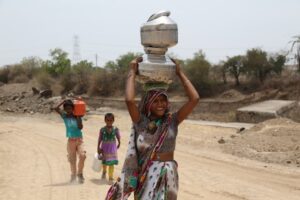Physical Address
23,24,25 & 26, 2nd Floor, Software Technology Park India, Opp: Garware Stadium,MIDC, Chikalthana, Aurangabad, Maharashtra – 431001 India
Physical Address
23,24,25 & 26, 2nd Floor, Software Technology Park India, Opp: Garware Stadium,MIDC, Chikalthana, Aurangabad, Maharashtra – 431001 India

By Vivek Saini
India is grappling with a severe water crisis that poses a significant risk to its sovereign credit strength. The recent report by global rating firm, Moody’s, highlights how the country’s escalating water stress, exacerbated by climate change, rapid industrialisation, and urbanization, threatens its economic stability and resilience. Water security is crucial for maintaining economic growth, social stability, and overall resilience in the face of growing environmental challenges.
Economic Implications of Water Scarcity
India’s economic growth and industrial activities are increasingly straining its water resources. As the world’s most populous country, India’s water demand is escalating rapidly. According to Moody’s report, this scarcity threatens sectors heavily reliant on water, such as agriculture, coal power generation, and steel production.
Impact on Agriculture
Agriculture employs a significant portion of India’s population and is highly vulnerable to water shortages. Diminished water supply can disrupt agricultural production, leading to food inflation and reduced farmer income. This instability can cascade through the economy, causing social unrest and economic volatility. According to the NITI Aayog, nearly 75% of households do not have access to safe drinking water, and by 2030, 40% of India’s population will have no access to drinking water. This critical shortage will significantly impact agricultural productivity and food security.
Industrial Impact
Water-intensive industries like coal power and steel manufacturing face operational challenges due to water scarcity. Reduced water availability can lead to production slowdowns, increased operational costs, and potential shutdowns, adversely affecting the broader industrial sector’s contribution to GDP. Moody’s report highlights that sectors such as agriculture, energy, and manufacturing, crucial for economic growth, are particularly vulnerable to water stress.
Climate Change and Extreme Weather Events
The frequency and intensity of extreme weather events, such as droughts and prolonged heatwaves, exacerbate India’s water crisis. These events, driven by climate change, are particularly detrimental to major cities like New Delhi and Bengaluru, which struggle with severe water shortages annually.
Droughts and Heatwaves
Frequent droughts and heatwaves strain the already limited water resources, reducing agricultural yields and increasing the competition for water between various sectors and regions. This competition heightens the risk of social and political conflicts over water access. Moody’s report mentions that water scarcity is expected to worsen due to climate change, impacting water availability and quality across the country.
Monsoon Dependency
India’s reliance on the monsoon for water exacerbates the crisis. Erratic rainfall patterns due to climate change lead to periods of both excessive rainfall and severe drought, complicating water management efforts and impacting water availability. This dependency increases the vulnerability of water resources, making effective water management crucial for economic stability.
Moody’s reported a severe heatwave in June 2024, with temperatures hitting 50 degrees Celsius in Delhi and northern Indian states, further strained water supply. Floods, one of India’s most common types of natural disasters, disrupt water infrastructure. In 2023, floods in northern India and Cyclone Biparjoy in Gujarat caused economic losses estimated between $1.2-1.8 billion, per the State Bank of India. Additionally, monsoon rainfall is decreasing. The Indian Ocean warmed at a rate of 1.2 degrees Celsius per century during 1950-2020, projected to intensify to 1.7-3.8 degrees Celsius during 2020-2100. Monsoon rainfall in 2023 was 6% less than the average for 1971-2020, with a significant shortfall in August.
Long-term risk to creditworthiness and its solution
Moody’s report underscores the long-term risks that water scarcity poses to India’s sovereign credit strength. As the competition for water intensifies, the potential for economic disruptions and social unrest increases, weakening the country’s ability to withstand external shocks.
Credit Strength
The water crisis can erode investor confidence and increase the cost of borrowing for the Indian government. Persistent water shortages and their associated economic impacts can lead to downgrades in credit ratings, making it more expensive for India to finance its development projects and financial programs. Moody’s highlights that water scarcity is a significant environmental risk that could impact India’s credit profile over the medium to long term.
Governance and Policy Reforms
Effective water governance requires coordinated efforts between central and state governments. Transparent and accountable management practices are crucial for equitable water distribution and dispute resolution. The Indian government must overhaul its water policies to better address the current and future challenges posed by water scarcity.
Technological Innovations
Real-time data monitoring and advanced modelling can optimise water resource management, predict water needs, and prevent conflicts. Artificial intelligence and big data can enhance decision-making processes and improve water conservation efforts. Implementing decision support systems to manage reservoirs and water distribution networks can help mitigate the impacts of water scarcity.
Public Awareness and Community Engagement
Educating the public about the importance of water conservation and encouraging community-led initiatives can significantly contribute to sustainable water management. Programs like the Atal Bhujal Yojana emphasise the role of local communities in groundwater management. Promoting water conservation practices at the household level, such as rainwater harvesting and efficient water use, can also be crucial in addressing the water crisis.
References:
https://siwi.org/latest/water-crisis-india-everything-need-know
https://www.sciencedirect.com/science/article/abs/pii/S0048969723059697
https://blogs.worldbank.org/en/endpovertyinsouthasia/how-real-time-data-can-help-indias-water-crisis
Banner image:
Photo by Gyan Shahane on Unsplash